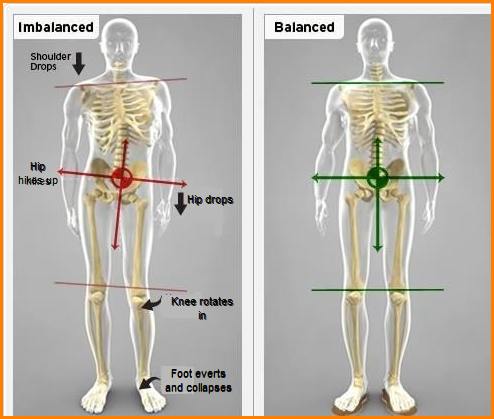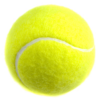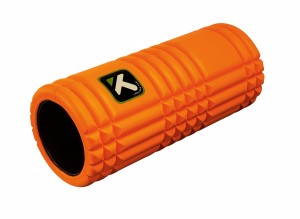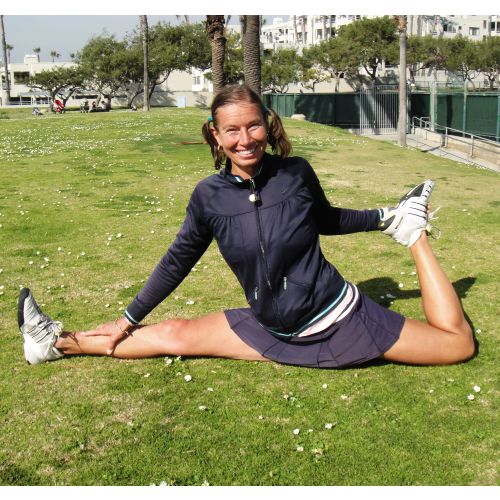The hardest thing in life and sport training is to remain balanced. In life, work, family, school, chores, studies, health, cooking and other duties call for your attention and you need to stay focused on giving all of them enough attention. In your sport training, you need to work on your strength, power, flexibility, quickness, your sport specific skills, mental toughness and injury prevention. Again, if you neglect any part for too long, it will show up and cause problems. Just like your life and training, your physical body (the musculoskeletal one) needs balance.
Playing tennis and sitting all the other times when you don’t play, create forces that tend to throw your body off the balance. For example, sitting too much shortens the hip-flexors, which causes a dysfunction in your gluteus, which prevents you from optimal running or walking gait and you will encounter problems. This is very simplified; the chain of events is often longer and more complicated, but you get the point.
Your goal as an athlete is to keep your body as balanced as it gets. Your feet and hips are the foundation for optimal movement and functionality. We have addressed the feet strengthening in several previous articles here: short foot exercise and intrinsic foot muscles. For a lot of people, feet training is boring. I cannot state any louder that you SHOULD PAY ATTENTION TO YOUR FEET. It is not that difficult, you can do it anytime, anywhere, and every little foot session will make a significant difference in the long term.
The hips are your power house. All the movement initiates in the hips, and any hip dysfunction spreads around your body just like the circles on the water when you throw in a pebble. You may not feel any compensations now, but soon it will show up in your body with tightness, pain, shortened muscles, weak muscles, tendon inflammations and even worse problems. Rather than reacting to your issues when they show up, a much better approach is to pay attention to your body now, so you never need to get to the stage of discomfort and pain, and possibly laying off your training.
When the kinetic chain gets off balance, it will affect many other joints and muscles in your body.

For the right-handed tennis player, it is very common that the left gluteus medius gets weak and inhibited (doesn’t work correctly) and other muscles need to compensate. The right hip gets overactive and overused (and tight). The TFL muscle, piriformis, gluteus medius, biceps femoris (hamstrings) and the adductors on the right side get too tight. The more overactive these muscles are, the more they inhibit your left hip’s muscles that continue to deteriorate.
You may risk strains of the hamstring, quadricep, or groin. Also, a nagging lower back pain caused from the overactive Quadratus lumborum is usually present.
To avoid any serious future issues, you need to address your imbalances proactively.
1) Strengthen your gluteus medius with exercises such as monster walk, one leg-balance, one-leg squat, side leg lifts, side planks with leg lifts.
2) Release the tight muscles on the opposite side: stretch and myofascial release for the gluteus medius and piriformis, myofascial release for TFL, stretch and myofascial release for the hamstrings.
3) Myofascial release for the lower and upper back.
4) Keep your spine mobile and subtle with the cats and dogs exercise, which is a gentle way of increasing your spine mobility. Do the spinal twist stretch.
5) Try this amazingly simple, yet rather effective isometric exercise to rebalance your hips.
6) For the upper back and shoulder functionality, do the arm circles and elbow touches. Strengthen all the muscles in the upper back and shoulder area, with the rubber band pulls, planks with lifting the limbs, windmills and other shoulder stabilizing exercises.
7) Always pay attention to the backside of your body. We tend to forget it because we don’t see it in the mirror each time when we take a peek. Strengthen the glutes with glute bridges, squats, one-leg squats, stiff-legged deadlifts, hip extensions, and similar. Train your backside much more than you train your front side. The stronger and more functional your glutes are, the more the hip-flexors in the front can relax and stop pulling, and your lower back discomfort will go away.
Recreating the balance in your body is not very complicated, but it demands a certain level of discipline and persistence. I always encourage my students that I rather see them doing 5 minutes every day, then waiting for the right moment to do a whole hour, but that moment never happens. Do a few movements when you watch TV. Do another few on the tennis court after your practice when you chat with your friends. You will be pleasantly surprised how fast you will get positive results. Many of the recommended exercises are conveniently summarized in my little book that is available on Amazon in print or e-book, if you wish to have your guide always with you in your tennis bag.
There is no substitute for action.
This is one of my favorite rollers that is firm enough to reach deep into your tissue and easy to carry around. I have one green one in my car, and an orange one at home. Like a myofascial scout, always ready 🙂




